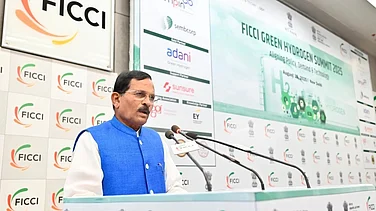In July the Centre said India will have a climate taxonomy soon. It is October and there is still no word on it yet. These things take time, is an apt excuse. Yet until there is a taxonomy, Indian banks will keep running around confused, unable to decide if the new project they seek to fund is green or not.
Sector-wise credit data from the past month shows Indian banks’ credit exposure to fossil fuel-based industries has grown by 20 per cent quarter-on-quarter. But as for green finance, that growth has been just upwards of 14 per cent.
In 2022, the Reserve Bank of India (RBI) said that 85 per cent of scheduled banks had promised to change their lending and investing approach to support green financing. A year later, only 10 Indian banks could provide numbers on the amount of credit they had given to green initiatives, according to a report by Climate Risk Horizons (CRH), an Indian research firm that specialises in climate financing.
Nine other banks said that while they were financing green projects, they could not provide numbers. A substantial 44 per cent of banks did not have a clue on what to do about green financing.
And that is a problem.
Climate change has the potential to dismantle the business models of banks in two key ways, according to the Basel Committee on Banking Supervision, one of the top banking bodies in the world with members that include central banks and bank supervisors from 28 jurisdictions.
First, banks may suffer from the financial losses due to the rising frequency of extreme climate events (India saw 318 such events in the 365 days of 2023).
And second, as economies seek to reduce carbon emissions, a move towards green energy backed by governments and technology, may generate significant losses for the banking sector heavily invested in non-green industries.
Why Are Indian Banks Confounded?
In short, because India is yet to formulate its own climate taxonomy.
A climate taxonomy is a framework that helps decide whether a new investment is green or not. Several countries have already come up with their own taxonomies. Singapore, for example, has laid out a taxonomy that seeks to phase out coal financing. This has allowed a bank like DBS to support an Asian coal phase-out.
Canada, China and Mexico have also come up with their own taxonomies. China, after laying out its taxonomy, realised that the default rate on loans for green projects was 0.4 per cent, much lower than the average of around 2 per cent.
Indian public sector banks on the contrary have seen an increase in investments in coal-related projects.“The coal exposure remains significant for most public sector banks, which lack a clear phase-out policy, while medium-sized private sector banks have been more proactive in implementing such policies,” says Sagar Asapur, head of sustainable finance at CRH.


The banks that have been able to pivot towards green financing—the likes of Federal Bank and HDFC Bank—have had to depend on external standards, and that is difficult because definitions of green financing need to factor in the stage of development of an economy. Thus, while Singapore may define its green financing by the financier’s approach to coal, that approach might not work in India.
And banks that have adopted green financing are feeling the pinch.
Take, for example, the Federal Bank. This Kerala-headquartered bank has decided to stop financing coal-based projects and has started using the ‘climate loan’ definition used by multilateral development banks. But the move has been fraught with challenges. “The lack of a green taxonomy is a real challenge. We have a dedicated E&S (environmental and social risks) division which evaluates each green loan proposal and verifies whether the loan is qualified as green,” says Damodaran C, vice-president and chief risk officer at Federal Bank.
The senior executive further says, “[Climate] taxonomies require specific certifications and have thresholds aligned to the overall maturity of the economy where they are developed. Thus, having an Indian taxonomy aligned to India’s priorities and thresholds considering the preparedness levels of micro-, small- and medium-enterprises and the agriculture sector in India is crucial. Some of the requirements under global taxonomies may be very complex and can result in increased compliance costs for borrowers.”
The Case for a Quick Taxonomy
The absence of a climate taxonomy is significantly slowing down progress on the green financing front, according to Sheetal Sharad, chief ratings officer at ICRA ESG Ratings. It is also leading to banks devising their own definitions that might not stand once the government comes up with its taxonomy.
Kotak Mahindra, Yes Bank and RBL Bank are using their own tools and assessment frameworks. Some other banks are using measures of climate risks based on returns on portfolios of underused fossil fuel reserves to identify green financing; some others are focusing entirely on carbon footprints.
A recent RBI survey shows that most banks are not linking their climate-related financial disclosures with any internationally-accepted framework. When Outlook Business reached out to senior officials from Bank of Baroda, they said that there are no concrete guidelines yet on green financing.
In the absence of a taxonomy, the RBI has laid out some principles and has also conducted a preliminary stress test. But the framework of these tests has not led to policy formulation. Meanwhile, Asapur says, “Private sector banks also tend to lead in disclosing climate-related data, though public sector banks have shown improvement following the RBI’s Draft Disclosure framework for climate-related financial risks.
Initial details [of an Indian climate taxonomy] are not yet available to the public,” he notes. He adds that while the government is pursuing a broader carbon credit trading mechanism, there is no clarity on how the taxonomy will be applied, particularly whether it will classify sectors based on their emission levels or focus on hard-to-abate sectors like power, shipping, cement or steel.
Thus an Indian climate taxonomy is the need of the hour. Any more delay will derail long-term plans of banks. If a section of banks continues to formulate their own green financing framework, those frameworks may come into question once the government’s taxonomy comes into play. Add to that, a well-framed Indian taxonomy is extremely important in a world where private capital is pumping in money into green initiatives and hegemonic members of the Global North are defining what is green and what is not.
































